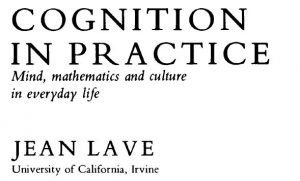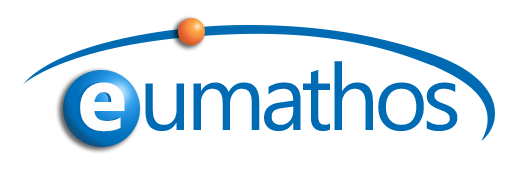Théories et pratiques de l’apprentissage situé 29/101

Cognition in practice (12/n)

Introduction
Dans ce billet de la série consacrée au 5eme chapitre du livre de Jean Lave intitulé Cognition in Practice, nous allons résumer la section intitulée « Ressources structurantes »
Dans ce passage Jean Lave nous montre comment deux activités peuvent se structurer mutuellement, et cela de manière variable, elle commence par nous décrire l’une des manière d’effectuer l’opération suivante: 75×114
Ensuite elle nous présente deux activités structurantes intéressantes, le tricot et la lecture qui tour à tour s’envisagent comme ressource structurante pour l’autre processus. Dans un long passage, Jean Lave s’intéresse à l’évolution du curriculum dans l’histoire des mathématiques à l’école (aux Etats-Unis) et à l’impact sur la manière d’organiser les expérimentations,
Enfin, les enseignements de deux expérimentations sont évoqués et font l’objet de la suite du chapitre, ce qui sera présenté dans le prochain billet.
Ressources structurantes (extraits principaux)
Où l’on voit qu’il y a plus d’une manière de calculer 75 x 114
« Suppose you are asked to solve a math problem like 75 x 114. A school
taught scenario is one possibility: Get out paper and pencil, use a place
holding algorithm, write 114, below it x 75, draw a line beneath,
multiply from right to left, 5 x 4. carry 2, 5 x 1 is 5 plus 2 is 7,5 x 1 is 5,
move to the left, 7 x 4. carry 2, 7 x 1 plus 2, 7 x 1. writing down the
answers all along. Then add down the answer columns. Or, use a
calculator, punch in 7, then 5, the multiply button, then 1, 1,4, the total
button, and read the answer on the display. Or, ask a friend, « how much
is 75 times 114? » « Well, let’s see … »
[…]
« The product may very well be the same in each case, but the process has been
given structure – ordered, divided into units and relations, in action –
differently in each case. »
Quand les gens font leurs courses et des maths en même temps:
People routinely shop for groceries and do math at the same
time.
Le tricot: une ressource structurante pour la lecture et vice versa
« Knitting is a structuring resource for the process of reading and reading provides structuring resources that give shape and punctuation to the process of knitting. They shape each other, but not necessarily equally. Usually one is the ongoing activity, the other is given shape more than it shapes the first. »
Un exemple plus vaste, est l’articulation entre le curriculum et la pratique quotidienne des mathématiques
« A much broader example of the articulation of structuring resources involves relations between the structuring of school math curricula and everyday math practices at different times in the history of public schooling.
The curriculum consisted of what Cohen calls « denominate math, » systems of weights, measures and their equivalents, for different branches of commerce – the latter provided the structuring resources for the school curriculum. I t organized teachers’ and children’s day-to-day activities. Perhaps they first learned fish sellers’ weights and
measures, then grain sellers, then carpenters’, then cloth merchants. »
Again, the concerns and activities of the marketplace provided the structuring resources for school activity.
By the end of the nineteenth century, there was a reversal of the impact of everyday math on school math curricula, such that what had become the relatively independent teaching of math as a structure in school settings, began to be justified as a universalistic and rational prescription for structuring arithmetic practice in other aspects of everyday life (including commerce).
La construction de situations d’expérimentation « valides écologiquement » n’est pas simple car d’autres choses que les propriétés mathématiques formelles interviennent dans la forme du problème, en pratique.
« But if math practice takes form in situationally specific ways (the very term « ecological validity » introduces this possibility), it implies that the formal mathematical properties of potential problems are not sufficient to determine what
problems will emerge in practice. Other factors in the situation shape problems: ongoing activities, the structure of the setting, and their relations. »
Construire des expériences valides écologiquement exige de définir comment les mathématiques interviennent dans l’enquête (investigation)
« To construct ecologically valid experiments requires a stipulation of how realizations of math other than a normative – scholastic one will figure in the investigation. Is the activity to be investigated the application of school math or grocery shopping (math) or some other form? »
Il n’existe pas de réponse toutes prêtes sur la manière de procéder
« There are no ready-made answers to these questions. In practice, research that has tried to address questions of ecological validity has included varied, generally conflicting strategies for connecting experiments with situated activity outside the laboratory without rethinking their theoretical underpinnings, construction, or interpretation. Sometimes the results seem almost absurd. »
La comparaison de deux expériences sur le raisonnement proportionnel devrait nous éclairer
« Comparison of the two proportional reasoning experiments may help to make the argument clearer. In one of these studies Capon and Kuhn investigated adult levels of cognitive development, focusing on unit price calculations for supermarket products. »
Les résultats, dans la suite du chapitre (notre prochain billet)
« Their results, discussed next, tell a clear story and establish two points: problem-solving success rates are quite different in the two experiments, and the experimenters’ analyses of subjects’ strategies is based on quite different principles of interpretation. Analysis in terms of structuring resources follows the description of the experiments. »
Billets précédents
Billet 1: Définitions de l’apprentissage situé
Billet 2: Pourquoi s’intéresser à la théorie de l’apprentissage situé?
Billet 3: Démarche et retour aux sources
Billet 4: Mai 1968 et l’apprentissage situé
Billet 5: Apprentissage situé et conversation
Billet 6: Lucy Suchman, mon téléphone portable et moi
Billet 7: Conversations avec moi-même (n° 1)
Billet 8: L’apprentissage situé mis en pratique, cela ferait quoi?
Billet 9: Contribution de la psychologie soviétique à la théorie de l’apprentissage situé
Billet 10: Les apports de la philosophie à la théorie de l’apprentissage situé
Billet 11: Focus sur l’école Dewey
Billet 12: Apports de la psychologie de la perception – la notion d’affordance
Billet 13: Apprentissage situé et intelligence artificielle, deep learning, réalité virtuelle, réalité augmentée, etc…
Billet 14: Conversations avec moi-même (N°2)
Billet 15: Quand John Dewey rencontre Jean Lave
Billet 16: Cognition in Practice (1/n)
Billet 17: Cognition in Practice (2/n)
Billet 18: Cognition in Practice (3/n)
Billet 19: Cognition in Practice (4/n)
Billet 20 : Cognition in Practice (5/n)
Billet 21: « Conversations avec moi même N°3 »
Billet 22: Cognition in Practice (6/n)
Billet 23: Cognition in Practice (7/n)
Billet 24: Cognition in Practice (8/n)
Billet 25: Cognition in Practice (9/n)
Billet 26: Cognition in Practice (10/n)
Related Posts
Théories et pratiques de l’apprentissage situé 10/101
Communautés de pratique et management de la formation – 4/6
Théories et Pratiques de l’apprentissage situé 65/101
Articles récents
Archives
- mars 2024
- janvier 2024
- décembre 2023
- septembre 2023
- juin 2023
- avril 2023
- mars 2023
- janvier 2023
- octobre 2022
- septembre 2022
- juillet 2022
- mai 2022
- avril 2022
- mars 2022
- février 2022
- janvier 2022
- octobre 2021
- août 2021
- juillet 2021
- mai 2021
- février 2021
- juin 2020
- mai 2020
- avril 2020
- février 2020
- janvier 2020
- décembre 2019
- novembre 2019
- octobre 2019
- septembre 2019
- août 2019
- juillet 2019
- mai 2019
- avril 2019
- mars 2019
- février 2019
- janvier 2019
- décembre 2018
- septembre 2018
- août 2018
- juillet 2018
- juin 2018
- mai 2018
- avril 2018
- mars 2018
- février 2018
- janvier 2018
- décembre 2017
- novembre 2017
- octobre 2017
- septembre 2017
- août 2017
- juin 2017
- mai 2017
- avril 2017
- mars 2017
- février 2017
- janvier 2017
Catégories
- Actualités
- Adaptive Learning
- Allemagne
- Apprendre
- Apprentissage
- Branding
- Business
- Coaching
- Codeveloppement
- Communautés de pratique
- Deep learning
- Design
- Development
- E-Learning
- Ecole
- Education
- Europe
- Formation
- IA
- Intelligence articificielle
- LBC
- metacognition
- Non classé
- Orientation
- orientation
- Philosophie
- Poésie
- Réalité Augmentée
- Réalité Virtuelle
- Transition digitale
- WOL




Commentaires récents